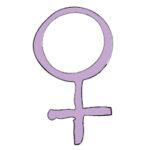 A vaginal septum (pronounced vaj-i-null sep-tum) is when the vagina is divided into two sections. In the case of a “longitudinal septum”, the sections are vertical (up and down) creating two vaginas. You may be wondering how this might happen.
A vaginal septum (pronounced vaj-i-null sep-tum) is when the vagina is divided into two sections. In the case of a “longitudinal septum”, the sections are vertical (up and down) creating two vaginas. You may be wondering how this might happen.
The reproductive system; uterus, fallopian tubes, ovaries, cervix, and vagina of a female baby begins to develop during the third month of pregnancy. The vagina normally forms as two tubes (or canals) that meet in the middle. As the vagina continues to develop, the two vaginal canals fuse (come together) to create a single vagina. Sometimes, during development, the vaginal canals don’t fuse like they’re supposed to, which results in a “vaginal septum”.
We don’t know the exact number of girls who are born with this condition, but it’s fairly common. A young woman may not know she has a vaginal septum (since you can’t see this condition from the outside) until she starts her period or becomes sexually active for the first time. Typically, a girl who has a vaginal septum may tell her health care provider that she has vaginal bleeding (on her underwear) even though she has a tampon in, or she may mention that she has discomfort with sexual intercourse. This is because there are two sides to the vagina.
Vaginal septum CAN be treated with a fairly simply surgical procedure that involves removing the tissue in the middle, to create a single vagina. When the septum is corrected, tampon use and sex are usually comfortable.
Our health guides are developed through a systematic, rigorous process to ensure accuracy, reliability, and trustworthiness. Written and reviewed by experienced healthcare clinicians from Boston Children's Hospital, a Harvard Medical School teaching hospital and consistently ranked as a top hospital by Newsweek and U.S. News & World Report, these guides combine clinical expertise, specialized knowledge, and evidence-based medicine. We also incorporate research and best practices from authoritative sources such as the CDC, NIH, PubMed, top medical journals, and UpToDate.com. Clinical specialists and subject matter experts review and edit each guide, reinforcing our commitment to high-quality, factual, scientifically accurate health information for young people.